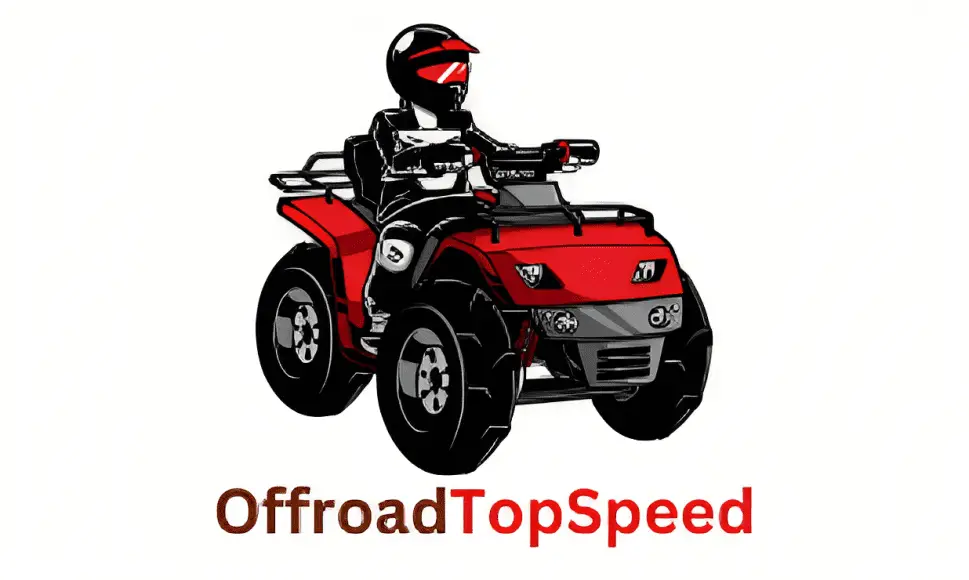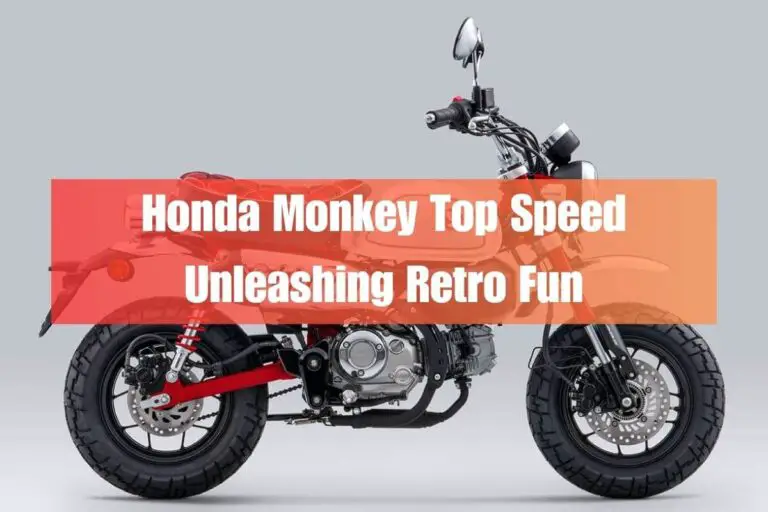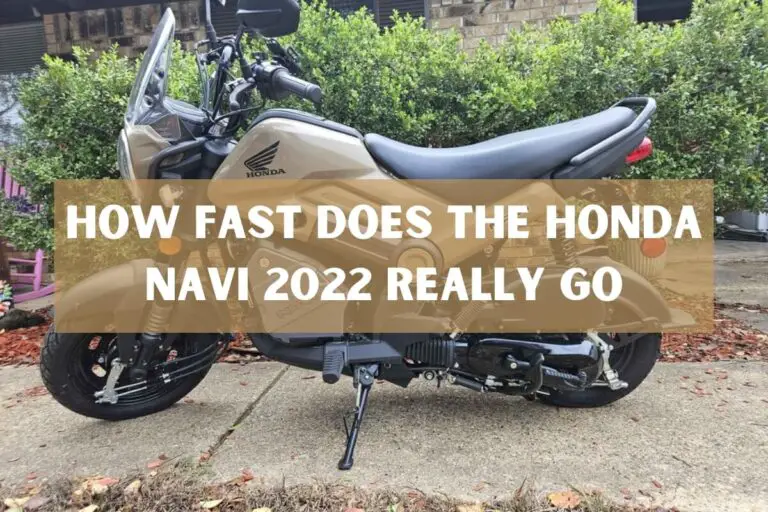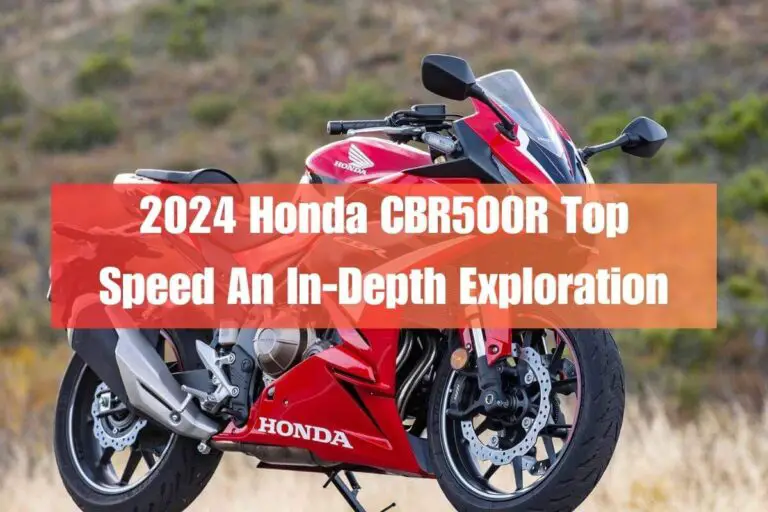Honda Trail 125 Top Speed: Unleashing the Mini Monster
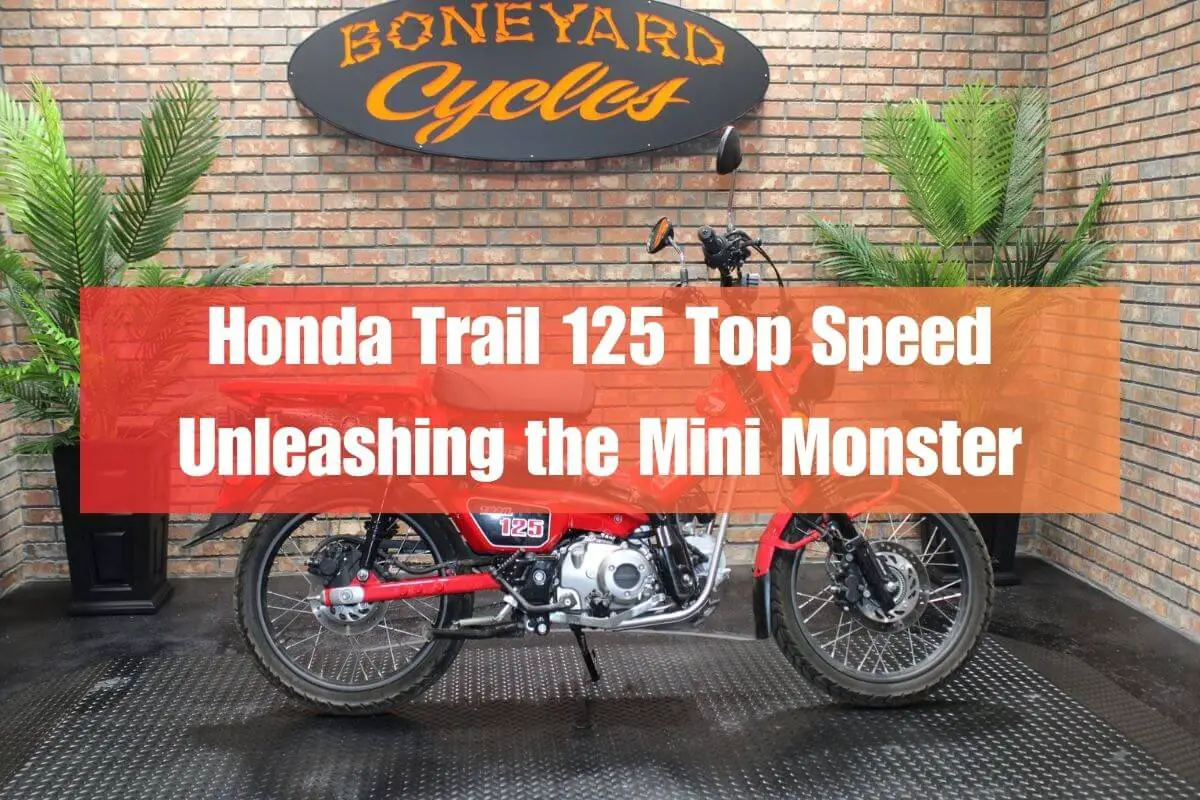
The Honda Trail 125 is a miniature powerhouse on two wheels, packing a surprising punch for its compact size. With its fuel-injected 125cc engine and lightweight design, this pint-sized trail bike can reach top speeds that might surprise you. Today, we are going to explore the exhilarating top speed of the Honda Trail 125, dive into its performance factors, and compare it to other mini motorcycle contenders. Get ready to unleash the mini monster within!
Highlights of the Honda Trail 125
Before we delve into the nitty-gritty of top speed, let’s familiarize ourselves with the Honda Trail 125’s key highlights:
- Retro-inspired design with modern amenities: The Trail 125 pays homage to Honda’s iconic dual-sport Trails of the past, but with a modern twist. Its classic styling is complemented by features like fuel injection and disc brakes.
- User-friendly four-speed semi-automatic transmission: No need to worry about a clutch lever! The Trail 125 features a four-speed semi-automatic transmission that you can shift with your left foot, making it incredibly user-friendly.
- Capable of on-road and off-road adventures: With its light weight, skid plate, spark arrestor, and good ground clearance, the Trail 125 is ready to tackle city streets as well as mild off-road trails.
- Standard ABS for added safety: Honda equips the Trail 125 with standard front-wheel Anti-lock Braking System (ABS), providing extra confidence when braking on less-than-ideal surfaces.
What is the Top Speed of the Honda Trail 125?
Now, let’s address the burning question – what is the top speed of the Honda Trail 125? According to Honda, the Trail 125 can reach a claimed top speed of 55-60 mph (88-96 km/h).
However, real-world experiences from owners can vary. Some riders have reported being able to push the Trail 125 to around 65 mph (105 km/h) on level ground, while others have mentioned struggling to surpass 50 mph (80 km/h) due to factors like rider weight, wind resistance, and terrain.
Here’s what a few Trail 125 owners had to say about their top speed experiences:
“I’ve gotten my Trail 125 up to 63 mph on a slight downhill, but realistically, it’s happiest cruising between 45-55 mph on flat ground.” – Trail125Rider, Reddit
“Don’t expect to sustain speeds much above 50 mph for long periods. The little 125cc engine starts to feel buzzy and strained at those higher velocities.” – TrailAdventures, Online Forum
As you can see, the Honda Trail 125’s top speed can vary based on several factors, including gearing, engine tuning, rider weight, terrain, and wind resistance.
Acceleration and Performance
While top speed is an essential metric, acceleration and overall performance are equally crucial when it comes to the Honda Trail 125’s capabilities.
Unfortunately, Honda doesn’t provide official 0-60 mph (0-96 km/h) acceleration times for the Trail 125. However, its lightweight construction (claimed curb weight of 256 lbs/116 kg) and fuel-injected 125cc engine with 9 horsepower give it a respectable power-to-weight ratio.
This translates to peppy acceleration off the line and excellent low-end torque, making the Trail 125 an agile and responsive performer, especially in urban environments and on trails.
Specifications
Here’s a quick overview of the Honda Trail 125’s key specifications that contribute to its performance:
| Specification | Value |
|---|---|
| Engine | 124cc, air-cooled, SOHC single-cylinder |
| Bore x Stroke | 50.0 x 63.1 mm |
| Compression Ratio | 10.1:1 |
| Fuel Delivery | PGM-FI with 24mm throttle body |
| Transmission | 4-speed semi-automatic |
| Front Suspension | 27mm telescopic fork, 4.3 in. travel |
| Rear Suspension | Twin shocks, 3.4 in. travel |
| Front Brake | 220mm disc with ABS |
| Rear Brake | 190mm disc |
| Wheels | 17-inch spoked rims |
| Tires | 80/90-17 front and rear |
| Rake/Trail | 27.0°/3.1 in. |
| Wheelbase | 49.4 in. |
| Seat Height | 31.5 in. |
| Fuel Capacity | 1.4 gal. |
| Curb Weight | 256 lbs. |
What Determines the Top Speed of the Trail 125?
Several factors play a role in determining the Honda Trail 125’s top speed capabilities. Let’s explore them in detail:
Engine Capacity and Power Output
At the heart of the Trail 125’s performance lies its 124cc, air-cooled, single-cylinder engine. While not a powerhouse by any means, this fuel-injected mill churns out a respectable 9 horsepower, which is more than enough for its intended purposes.
However, as you might expect, the engine’s modest displacement and power output are the primary limiting factors when it comes to outright top speed.
Gearing and Transmission Ratios
The Trail 125’s four-speed semi-automatic transmission and final drive gearing also play a crucial role in how fast it can go. With a larger rear sprocket (38 teeth) and shorter overall gearing, Honda has tuned the Trail 125 for enhanced low-end torque and off-road prowess.
While this gearing setup excels in trails and technical terrain, it ultimately limits the bike’s potential for higher top speeds on open roads.
Aerodynamics and Drag
Let’s face it – the Honda Trail 125 wasn’t designed with aerodynamics in mind. Its upright riding position and boxy styling create more wind resistance at higher speeds, further capping its maximum velocity.
Additionally, the Trail 125’s lightweight construction means it can be affected more by crosswinds and air turbulence, making it susceptible to getting pushed around at elevated speeds.
Terrain and Riding Conditions
Finally, the terrain and riding conditions can significantly impact the Honda Trail 125’s top speed performance. On smooth, level pavement, it might be able to reach its claimed top speed more easily.
However, throw in inclines, rough surfaces, or strong headwinds, and that top speed figure becomes increasingly difficult to attain and sustain.
Owner Reviews: The Good and the Bad
To better understand the Honda Trail 125’s real-world performance, let’s take a look at what owners have to say about the good, the bad, and everything in between:
Positive Reviews
“The Trail 125 is an absolute blast to ride! It might not be the fastest bike out there, but it’s incredibly flickable and confidence-inspiring, especially on tight city streets and light trails.” – HondaTrailFan, Online Review
“For a beginner-friendly bike, the Trail 125 packs a surprising punch off the line. Its low-end torque makes it feel much more spirited than you’d expect from a 125cc engine.” – RidingNewbie, Reddit
“The best part about the Trail 125 is its versatility. One day, you can commute to work on it, and the next, you can take it out for some mild off-road adventures. It’s a jack-of-all-trades!” – DualSportEnthusiast, Forum Post
Negative Reviews
“Don’t expect to sustain highway speeds on the Trail 125 for too long. It starts to feel buzzy and strained once you push past 55-60 mph, which can be unsettling.” – CityCommuter, Online Review
“While the Trail 125 is great for urban riding and light trails, its suspension can feel a bit underdamped and overwhelmed when you start hitting more aggressive off-road terrain.” – OffRoadJunkie, Forum Comment
“The lack of storage space can be frustrating if you plan on using the Trail 125 for longer rides or commutes. You’ll need to invest in some luggage accessories.” – WeekendWarrior, Reddit
As you can see, owners appreciate the Honda Trail 125’s nimble handling, user-friendly nature, and versatility for urban commuting and mild off-road adventures. However, its limited top speed, modest suspension for aggressive off-roading, and lack of storage space are common points of criticism.
How Does the Trail 125’s Top Speed Compare to Competitors?
To better understand the Honda Trail 125’s top speed performance, let’s pit it against some of its key competitors in the mini motorcycle and dual-sport segment:
Yamaha TW200
The Yamaha TW200 is often regarded as one of the Trail 125’s closest rivals. Powered by a larger 196cc air-cooled engine, the TW200 boasts a claimed top speed of around 70 mph (113 km/h), giving it a slight edge over the Honda.
However, the TW200’s added weight (292 lbs/132 kg curb weight) and more off-road-focused design can make it feel less nimble and agile in city riding scenarios.
Honda Navi
Honda’s own Navi is another automatic-transmission mini motorcycle that competes with the Trail 125 in terms of user-friendliness and urban mobility. With a 109cc engine, the Navi’s top speed is rated at around 55 mph (89 km/h), putting it on par with the Trail 125.
That said, the Navi lacks the Trail 125’s off-road capabilities and retro-inspired styling, making it a more city-focused option.
Kawasaki Z125 Pro
For those seeking a little more sportiness, the Kawasaki Z125 Pro is a popular choice. This lightweight naked bike boasts a top speed of around 70 mph (113 km/h) thanks to its 125cc liquid-cooled engine and aggressive riding position.
However, the Z125 Pro’s lack of off-road capabilities and more committed riding ergonomics make it less versatile than the Honda Trail 125.
While the Honda Trail 125 might not be the outright top speed king in its class, its balanced blend of performance, user-friendliness, and versatility make it a compelling option for many riders.
Modifications to Increase Top Speed
If you’re seeking to eke out a few extra miles per hour from your Honda Trail 125, there are several modifications you can consider:
Exhaust System Upgrades
Installing an aftermarket slip-on exhaust or full exhaust system can help increase the Trail 125’s top speed by reducing back pressure and allowing the engine to breathe more freely. Look for options that promise modest power gains without compromising rideability.
Air Intake Modifications
Pairing an aftermarket exhaust with a performance air filter or cold air intake can further enhance the Trail 125’s power output and top speed potential. Just be sure to choose quality components designed specifically for your bike.
Gearing Changes (Sprocket Swaps)
Swapping out the Trail 125’s stock rear sprocket for one with fewer teeth can effectively “tall-en” the final drive ratio, allowing the engine to rev higher and potentially reach a higher top speed. However, this modification will likely compromise low-end torque and off-road capability.
ECU Tuning and Remapping
For the more tech-savvy riders, reflashing the Trail 125’s engine control unit (ECU) with a performance tune or remap can help extract a bit more power and top-end speed from the 125cc mill. This process often requires specialized equipment and expertise.
Remember, any modifications you make to your Honda Trail 125 could potentially void its warranty, so proceed at your own risk and consult with knowledgeable professionals.
Pros and Cons of the Honda Trail 125
To help you better evaluate if the Honda Trail 125 is the right fit for your needs, let’s take a look at some of its key pros and cons:
Pros:
- Lightweight and flickable handling
- Affordable and economical to own and operate
- Beginner-friendly thanks to its automatic transmission and low seat height
- Versatile for urban commuting and mild off-road adventures
- Retro-inspired styling with modern touches like fuel injection and ABS
- Low maintenance requirements and excellent reliability (it’s a Honda, after all!)
Cons:
- Limited top speed (55-60 mph) makes it inadequate for sustained highway riding
- Modest suspension travel can feel overwhelmed on more aggressive off-road terrain
- Lack of storage space can be inconvenient for longer rides or commutes
- Modest power output might leave more experienced riders wanting for extra oomph
- Upright riding position and lack of wind protection can be tiring at higher speeds
As you can see, the Honda Trail 125 excels as an affordable, user-friendly, and versatile mini motorcycle for urban environments and mild off-road adventures. However, its limited top speed and modest suspension might make it less appealing for those seeking high-speed thrills or hardcore off-road capabilities.
Top Alternatives to the Honda Trail 125
If the Honda Trail 125 doesn’t quite scratch your itch, here are some top alternatives worth considering:
Yamaha TW200
As mentioned earlier, the Yamaha TW200 is a direct competitor to the Trail 125 in the dual-sport mini motorcycle segment. With a larger 196cc engine, more off-road-focused design, and a claimed top speed of around 70 mph, the TW200 might better suit those seeking a bit more capability and performance, albeit at the expense of some urban maneuverability.
Royal Enfield Himalayan
If you’re looking for a more adventure-ready option, the Royal Enfield Himalayan is a rugged and affordable choice. Powered by a 411cc air-cooled single-cylinder engine, the Himalayan boasts a claimed top speed of around 90 mph, making it a more capable option for occasional highway stints. However, its larger size and weight make it less well-suited for tight city riding than the Trail 125.
Honda Grom
For those prioritizing pure urban fun over off-road capabilities, Honda’s own Grom is a popular choice. This pocket-sized motorcycle packs a 125cc engine and a claimed top speed of around 60 mph, making it a worthy rival to the Trail 125 in the city streets. However, its lack of off-road prowess and more committed riding position might make it less versatile than the Trail 125.
Honda Monkey
Another quirky Honda offering, the Monkey shares its 125cc engine and underpinnings with the Trail 125, but with a more retro-inspired mini-bike styling. Its claimed top speed is similar to the Trail 125, but its compact dimensions and upright ergonomics make it better suited for urban shenanigans than off-road adventures.
Ultimately, the best alternative for you will depend on your specific needs, riding preferences, and intended use case.
Pricing and Availability
If the Honda Trail 125 has piqued your interest, you’ll be pleased to know that it’s one of the more affordable options in the mini motorcycle segment. For the 2024 model year, the Trail 125 carries an MSRP of $4,099 in the United States.
However, keep in mind that dealer pricing can vary based on location, demand, and any applicable fees or taxes. It’s always a good idea to shop around and negotiate to get the best deal possible.
As for availability, the Trail 125 is a relatively popular model in Honda’s lineup, so you should be able to find it at most dealerships without significant wait times. However, popular color options or limited editions might be subject to longer lead times or waitlists, so it’s best to inquire with your local dealer for the most up-to-date information.
Who Should Buy the Honda Trail 125?
Based on its performance capabilities, features, and limitations, the Honda Trail 125 is an excellent choice for several types of riders:
Urban Commuters and City Riders
If you’re looking for an affordable, fuel-efficient, and easy-to-maneuver motorcycle for navigating busy city streets, the Trail 125 is an excellent option. Its lightweight chassis, automatic transmission, and nimble handling make it a joy to ride in stop-and-go traffic and tight urban environments.
Beginner Riders and Riding Schools
The Trail 125’s user-friendly nature, forgiving power delivery, and low seat height make it an ideal choice for beginner riders or riding schools. Its automatic transmission eliminates the need to worry about operating a clutch, allowing new riders to focus on developing their skills and building confidence.
Weekend Adventure Seekers
With its capable off-road prowess (within reason) and versatile dual-sport design, the Trail 125 is a fantastic choice for those seeking weekend adventures on mild trails, fire roads, or other light off-road terrain. Its lightweight and manageable nature make it a great option for exploring the great outdoors without the intimidation factor of a larger, more powerful adventure bike.
However, it’s important to note that while the Trail 125 can handle mild off-road conditions, it’s not designed for extreme or aggressive off-roading. Its modest suspension travel and ground clearance might prove inadequate for tackling more challenging terrain, such as rocky paths, deep ruts, or steep inclines.
Commuters on a Budget
With its affordable pricing, excellent fuel efficiency, and low maintenance costs, the Honda Trail 125 can be an attractive option for cost-conscious commuters looking for an economical way to navigate their daily commute. Its small footprint and maneuverability also make it a viable choice for those dealing with tight parking spaces or congested urban areas.
Fun-Seeking Riders
Let’s not forget that the Honda Trail 125 is, above all, a fun and engaging little motorcycle. Its playful nature, approachable performance, and retro-inspired styling make it an excellent choice for riders who prioritize enjoying the pure pleasure of two-wheeled adventures, whether on city streets or mild off-road trails.
On the flip side, the Honda Trail 125 might not be the best choice for certain riders or specific use cases:
Highway Commuters or Touring Riders
With its limited top speed of around 55-60 mph, the Trail 125 is simply not well-suited for sustained highway riding or longer touring adventures. Its lack of wind protection, modest power output, and potential for fatigue at higher speeds make it a less-than-ideal choice for these types of riders.
Aggressive Off-Road Enthusiasts
While the Trail 125 can handle mild off-road conditions, its modest suspension travel and ground clearance will likely prove inadequate for those seeking more aggressive off-road adventures. Hardcore off-road enthusiasts or enduro riders would be better served by a more purpose-built and capable machine.
Performance-Oriented Riders
If you’re seeking adrenaline-pumping performance and outright speed, the Honda Trail 125’s modest 125cc engine and top speed limitations might leave you wanting more. In this case, a larger-displacement motorcycle or a dedicated sportbike would better suit your needs.
Ultimately, the Honda Trail 125 is a well-rounded and versatile mini motorcycle that excels in urban environments, light off-road adventures, and as a beginner-friendly or fun-focused ride. By understanding its strengths and limitations, you can better determine if it aligns with your specific riding needs and preferences.
Common Issues and Solutions
Like any motorcycle, the Honda Trail 125 isn’t immune to potential issues or problems. Here are some of the most common ones reported by owners, along with potential solutions:
Maintenance Requirements and Costs
One of the Trail 125’s biggest strengths is its relatively low maintenance requirements and costs. As a simple, air-cooled single-cylinder machine, regular maintenance tasks like oil changes, air filter replacements, and valve adjustments are generally straightforward and inexpensive.
However, it’s still important to adhere to the recommended maintenance schedule in your owner’s manual to ensure reliable operation and longevity.
Suspension Limitations
As mentioned earlier, the Trail 125’s modest suspension travel (4.3 inches front, 3.4 inches rear) can feel overwhelmed and underdamped when tackling more aggressive off-road terrain or larger obstacles. While upgrading to aftermarket suspension components can improve performance, it’s important to remember the Trail 125’s inherent limitations as a mini motorcycle.
Vibrations at Higher Speeds
Several owners have reported experiencing increased vibrations and buzziness when pushing the Trail 125 to its top speed limits, particularly when sustaining speeds above 55-60 mph for extended periods. This is likely due to the engine’s modest displacement and the bike’s overall lightweight construction.
Installing aftermarket handlebars with more vibration-damping qualities or adjusting the throttle body synchronization might help mitigate these issues to some degree.
Lack of Storage Space
The Trail 125’s minimalist design and compact dimensions come at the expense of storage space. While it does feature a modest rear rack, longer rides or commutes might necessitate the addition of aftermarket luggage solutions, such as saddlebags or a tank bag.
Battery Drain and Electrical Issues
Like many modern motorcycles, the Trail 125 can be prone to battery drain if left unused for extended periods. Additionally, some owners have reported electrical gremlins or issues with the bike’s lighting or instrumentation.
Keeping the battery on a trickle charger during periods of inactivity and ensuring all electrical connections are secure and free of corrosion can help prevent these types of problems.
While not an exhaustive list, being aware of these common issues can help you better prepare for and address any potential problems that might arise with your Honda Trail 125.
Frequently Asked Questions
Still have some lingering questions about the Honda Trail 125 and its top speed capabilities? Here are some frequently asked questions (and answers) that might help:
Is the Honda Trail 125 street legal?
Yes, the Honda Trail 125 is street legal and can be registered for on-road use in most regions. It comes equipped with all the necessary lighting, mirrors, and other safety equipment required for road-going motorcycles.
Can the Trail 125 be ridden on highways?
While the Trail 125 can technically be ridden on highways, its limited top speed of around 55-60 mph makes it less than ideal for sustained highway riding. It’s better suited for city streets, backroads, and light off-road adventures.
What is the fuel efficiency of the Honda Trail 125?
Honda doesn’t provide official fuel economy figures for the Trail 125, but many owners report achieving between 60-80 mpg (or even higher) in mixed riding conditions. Its 1.4-gallon fuel tank might be small, but it can still provide a decent range thanks to the bike’s excellent fuel efficiency.
How long does the battery last on the Trail 125?
The battery life on the Honda Trail 125 can vary based on factors like age, usage patterns, and ambient temperatures. Most owners report getting 1-2 years of service from the stock battery before needing to replace it.
To maximize battery life, it’s recommended to keep the battery on a trickle charger during periods of inactivity and to avoid leaving electrical accessories (like heated grips or accessory lighting) on for extended periods when the engine isn’t running.
Can the Honda Trail 125 be made faster with modifications?
While the Trail 125’s top speed is inherently limited by its small 125cc engine displacement, there are some modifications that can potentially eke out a few extra miles per hour. These include exhaust system upgrades, air intake modifications, gearing changes (sprocket swaps), and ECU tuning or remapping.
However, it’s important to keep in mind that any significant performance modifications might impact the Trail 125’s off-road capability, reliability, and warranty coverage. Proceed with caution and consult with experts before making any major changes.
Is the Trail 125 suitable for taller or larger riders?
With its compact dimensions and a seat height of 31.5 inches, the Honda Trail 125 might feel a bit cramped or undersized for taller riders or those with larger frames. However, its lightweight nature (256 lbs curb weight) and low center of gravity can help offset some of these ergonomic challenges.
Ultimately, it’s best to test ride the Trail 125 and ensure you can comfortably reach the ground and maintain proper control before making a purchase decision.
Final Thoughts
The Honda Trail 125 is a delightful little motorcycle that manages to strike an impressive balance between fun, affordability, and versatility. While its top speed might not set any land speed records, the Trail 125’s nimble handling, user-friendly nature, and capable off-road prowess make it an absolute joy to ride in urban environments and on mild trails.
Whether you’re a beginner rider seeking an approachable and forgiving machine, a seasoned veteran looking for a fun and economical weekend toy, or an urban commuter in need of an agile and efficient mode of transportation, the Honda Trail 125 has something to offer.
Just remember to keep your expectations in check – this is a mini motorcycle, after all. Its limited top speed and modest suspension travel mean it’s better suited for city streets, backroads, and light off-road adventures than sustained highway stints or aggressive off-road pursuits.
But if you embrace the Trail 125 for what it is – a playful, retro-inspired, and utterly engaging little dual-sport – you’ll be rewarded with a riding experience that’s pure, unadulterated fun.
